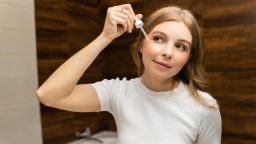Sustainability has become a key topic in many aspects of our lives, and the beauty industry is no exception. As consumers become more environmentally conscious, the demand for eco-friendly, sustainable beauty products has grown significantly. Making your beauty routine more sustainable not only helps the planet but also encourages healthier habits and supports brands that prioritize ethical practices. Transitioning to a sustainable beauty routine may seem overwhelming, but with a few mindful changes, you can reduce your environmental footprint while still looking and feeling your best. Here are some simple yet effective ways to make your beauty routine more sustainable.
- Choose Eco-Friendly Packaging
Packaging waste is one of the biggest culprits in the beauty industry’s environmental impact. Many beauty products come in plastic bottles or single-use packaging that end up in landfills. Opting for products with eco-friendly packaging can significantly reduce waste and promote a more sustainable beauty routine.
What to look for:
- Glass, metal, or bamboo packaging: These materials are more easily recyclable or biodegradable compared to plastic.
- Refillable options: Some brands offer refillable packaging, allowing you to reuse the same container multiple times. This helps cut down on packaging waste.
- Minimalist packaging: Some brands are focusing on minimalistic packaging to reduce excess waste, opting for simple, recyclable materials.
Why it works: By choosing products with sustainable packaging, you contribute to reducing plastic waste and help support brands that are committed to eco-friendly practices.
- Choose Clean Beauty Products
Clean beauty refers to products made with ingredients that are safe for both your health and the environment. Many traditional beauty products contain chemicals that can harm not only your skin but also the planet, as they often contain harmful ingredients that pollute waterways or are difficult to break down.
What to look for:
- Natural and organic ingredients: Look for beauty products made from natural, organic ingredients that are sourced sustainably and grown without harmful pesticides.
- Non-toxic formulas: Choose products free from parabens, sulfates, phthalates, and artificial fragrances.
- Cruelty-free brands: Many clean beauty brands are cruelty-free, meaning they don’t test on animals, which is an important aspect of sustainability.
Why it works: Clean beauty products are better for both your skin and the environment, as they use safe, eco-friendly ingredients that don’t pollute the planet.
- Reduce, Reuse, and Recycle Your Beauty Products
Incorporating the principles of reduce, reuse, and recycle into your beauty routine can help minimize waste. This can be done in several ways, from choosing multi-purpose products to recycling your empty packaging.
What to do:
- Use multi-purpose products: Choose products that can serve more than one function, such as a moisturizer with SPF or a tinted lip balm that can double as blush. This reduces the number of products you need, cutting down on packaging and waste.
- Recycle your beauty containers: Check if the packaging of your beauty products is recyclable. Many beauty containers, like glass jars and aluminum tubes, are recyclable, but others, such as pumps or mixed-material packaging, may not be.
- Repurpose your beauty containers: You can repurpose certain containers for other uses, such as using empty jars for storing small items or reusing bottles as plant waterers.
Why it works: Reducing your product consumption and reusing and recycling packaging helps cut down on unnecessary waste and encourages a more sustainable beauty routine.
- Embrace Minimalism in Your Beauty Routine
A minimalist approach to beauty not only saves time and money but also reduces the environmental impact of your routine. By focusing on the essentials, you can use fewer products and avoid overconsumption.
What to do:
- Streamline your routine: Focus on essential, high-quality products that work for your skin type and needs. Rather than having multiple products for different skin concerns, look for versatile products that address multiple concerns at once.
- Simplify your ingredients: Choose skincare and beauty products with fewer ingredients. These tend to have fewer chemicals and less packaging, which is better for the environment.
Why it works: A minimalist beauty routine reduces the number of products you use, which means less waste and fewer ingredients that require resource-intensive production processes.
- Switch to Reusable Beauty Tools
Many beauty tools, like cotton pads, makeup wipes, and disposable razors, contribute to waste, especially when used regularly. Switching to reusable beauty tools is an easy way to reduce your environmental footprint.
What to do:
- Reusable cotton pads: Instead of using single-use cotton pads to remove makeup, opt for washable, reusable cotton pads or cloths. Simply toss them in the laundry after use.
- Reusable makeup remover wipes: Reusable makeup wipes are made from soft, durable fabric and can be washed and reused multiple times, eliminating the need for disposable wipes.
- Bamboo toothbrushes: Swap out plastic toothbrushes for eco-friendly bamboo alternatives.
- Silicone beauty sponges: Instead of using disposable makeup sponges, try silicone beauty sponges that can be cleaned and reused.
Why it works: Reusable beauty tools help reduce waste by eliminating the need for single-use items, which contributes to a more sustainable beauty routine.
- Make Your Own Natural Beauty Products
One way to reduce packaging waste and control the ingredients in your beauty products is to make your own at home. DIY beauty products can be made using natural ingredients, such as coconut oil, honey, and essential oils, which are both eco-friendly and skin-friendly.
What to do:
- Homemade face masks and scrubs: You can create effective face masks or exfoliating scrubs using simple kitchen ingredients like oatmeal, avocado, or yogurt.
- Natural body lotions: Create your own body lotion or body butter using natural oils like almond, olive, or jojoba oil.
- Lip balms and hair masks: DIY lip balms and nourishing hair masks are simple to make using natural ingredients like beeswax, shea butter, and coconut oil.
Why it works: Making your own beauty products eliminates the need for packaged products and allows you to customize ingredients based on your skin type, making it both eco-friendly and cost-effective.
- Support Sustainable Beauty Brands
Supporting beauty brands that are committed to sustainability can have a significant impact. Many companies are adopting eco-friendly practices, from sourcing ingredients responsibly to reducing their carbon footprint.
What to do:
- Look for brands with certifications: Many sustainable beauty brands have certifications like Fair Trade, Leaping Bunny (cruelty-free), or ECOCERT (organic), which indicate their commitment to sustainability.
- Choose brands with ethical sourcing: Research brands that source ingredients responsibly and invest in fair wages and safe working conditions for workers.
- Support local businesses: Local brands may have a smaller environmental impact due to reduced transportation costs and a more localized supply chain.
Why it works: Supporting sustainable brands encourages the growth of ethical practices in the beauty industry and helps promote environmentally conscious products.
- Proper Disposal of Beauty Products
Not all beauty products can be recycled, and some may contain ingredients that require special disposal. Proper disposal of beauty products ensures they don’t contribute to environmental harm.
What to do:
- Dispose of chemicals safely: Don’t pour beauty products down the drain or toss them in the trash if they contain chemicals like nail polish or hair dye. Check with your local waste management for special disposal instructions.
- Recycling guidelines: Some beauty packaging, like aluminum, glass, or certain plastics, can be recycled. Make sure to rinse containers before placing them in the recycling bin to ensure they’re properly recycled.
Why it works: Proper disposal helps reduce pollution and ensures that harmful chemicals aren’t released into the environment.
Conclusion
Making your beauty routine more sustainable is all about being mindful of the products you use, the packaging they come in, and the impact they have on the environment. By choosing eco-friendly packaging, opting for clean beauty products, simplifying your routine, using reusable beauty tools, and supporting sustainable brands, you can significantly reduce your environmental footprint while still enjoying effective, beautiful skincare. Small changes can make a big difference in promoting a healthier planet, so start by making a few simple adjustments in your beauty routine today!





